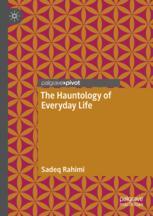Abstract This chapter outlines the basic objectives of the book and high- lights the general theoretical grounds on which the book develops its cen- tral argument that all human experience is fundamentally haunted. The primary points of reference include psychoanalytic theory, specifically Jacques Lacan’s object relational theory of ego development and his read- ing and expansion of Freud’s theory of the psychic apparatus and its dynamics; along with the Hegelian ontology of the negative and its later modifications by twentieth-century philosophers such as Heidegger and Derrida; and the semiotics of difference introduced by Saussure and worked by Jakobson and others. Whereas ontology can be read as an attempt to exorcise “reality as such” from the ambiguities that irreducibly haunt human experience of reality, hauntology is described here as an evo- cation that seeks not to exorcise, but simply to recognize and address the endless ghosts that are created by the very act of human perception and cognition, and hence subjective experience. Finally, hauntology is outlined here as a mode of understanding power and its working in ways funda- mentally different from historical, archaeological, or even a Foucauldian genealogical modality, in that instead of attempting to establish that which was, hauntological analysis seeks to recognize—to allow to come forward, to speak—that which had been to be but was not, that which could have been, the future that hailed the past but was forced to disappear from its horizon
چکیده فارسی
چکیده این فصل به تشریح اهداف اساسی کتاب می پردازد و مبانی نظری کلی را برجسته می کند که کتاب بر اساس آن استدلال اصلی خود را مبنی بر اینکه تمام تجربیات بشری اساساً خالی از سکنه است، توسعه می دهد. نقاط مرجع اولیه عبارتند از نظریه روانکاوی، به ویژه نظریه رابطه عینی ژاک لاکان در مورد رشد نفس و خوانش و بسط نظریه فروید در مورد دستگاه روانی و پویایی آن. همراه با هستی شناسی هگلی امر منفی و اصلاحات بعدی آن توسط فیلسوفان قرن بیستم مانند هایدگر و دریدا. و نشانه شناسی تفاوت که توسط سوسور معرفی شد و توسط یاکوبسون و دیگران کار شد. در حالی که هستیشناسی را میتوان به عنوان تلاشی برای حذف «واقعیت بهعنوان» از ابهاماتی خواند که بهطور غیرقابل کاهشی تجربهی انسان از واقعیت را تحت تأثیر قرار میدهند، در اینجا هاانتولوژی بهعنوان تداعی توصیف میشود که به دنبال جنگیری نیست، بلکه صرفاً برای شناخت و پرداختن به ارواح بیپایان است. که توسط خود عمل ادراک و شناخت انسان و در نتیجه تجربه ذهنی ایجاد می شوند. در نهایت، شبهشناسی در اینجا بهعنوان شیوهای از درک قدرت و کارکرد آن به روشهایی که اساساً متفاوت از شیوههای تبارشناسی تاریخی، باستانشناختی یا حتی فوکویی است، ترسیم میشود، بهطوریکه بهجای تلاش برای تثبیت آن چیزی که بوده است، تجزیه و تحلیل علفشناختی به دنبال تشخیص آن است. اجازه دادن به جلو آمدن، صحبت کردن - چیزی که باید باشد اما نبود، چیزی که می توانست باشد، آینده ای که از گذشته استقبال می کرد اما مجبور شد از افق خود ناپدید شود
ادامه ...
بستن ...
Abstract This chapter outlines the basic objectives of the book and high- lights the general theoretical grounds on which the book develops its cen- tral argument that all human experience is fundamentally haunted. The primary points of reference include psychoanalytic theory, specifically Jacques Lacan’s object relational theory of ego development and his read- ing and expansion of Freud’s theory of the psychic apparatus and its dynamics; along with the Hegelian ontology of the negative and its later modifications by twentieth-century philosophers such as Heidegger and Derrida; and the semiotics of difference introduced by Saussure and worked by Jakobson and others. Whereas ontology can be read as an attempt to exorcise “reality as such” from the ambiguities that irreducibly haunt human experience of reality, hauntology is described here as an evo- cation that seeks not to exorcise, but simply to recognize and address the endless ghosts that are created by the very act of human perception and cognition, and hence subjective experience. Finally, hauntology is outlined here as a mode of understanding power and its working in ways funda- mentally different from historical, archaeological, or even a Foucauldian genealogical modality, in that instead of attempting to establish that which was, hauntological analysis seeks to recognize—to allow to come forward, to speak—that which had been to be but was not, that which could have been, the future that hailed the past but was forced to disappear from its horizon
ادامه ...
بستن ...










